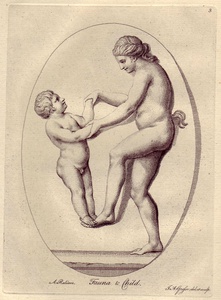| Method | Copper engraving |
| Artist | John Alexander Gresse |
| Published | [Salisbury, 1786] |
| Dimensions | Image 166 x 118 mm, Plate 188 x 136 mm, Sheet 195 x 142 mm |
| Notes |
A detail from an intaglio gem, featuring a female faun and child, from James Kennedy's 'A description of the antiquities and curiosities in Wilton-House' (1786). Carved gemstones, or intaglios, were popular in the classical world as seal-rings and ornamentation, reaching their artistic zenith in the Hellenistic and early Roman Imperial periods. John Alexander Gresse (1741-1794) was an English draughtsman, painter, and engraver. Born in London, Gresse studied drawing under Gerard Scotin, and and was one of the first students to work in the gallery of casts founded by the Duke of Richmond. In 1777, he was appointed drawing-master to the Royal Princesses. He occasionally practised etching, publishing 'St. Jerome' after Guido, and 'A Satyr Sleeping' after Poussin. Gresse was also a great collector of works of art, and an auction of his collection shortly after his death lasted for six days. |
| Framing | unmounted |
| Price | £20.00 |
| Stock ID | 9261 |

